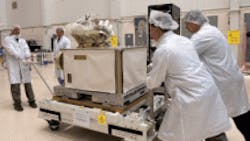NASA payload will test software-defined radios
|
Resources: NASA |
NASA will send its Space Communication and Navigation (Scan) Testbed to the Space Station sometime this year onboard a Japanese H-IIB launcher that will take off from the Japanese Aerospace Exploration Agency’s Tanegashima Space Center. (Japanese Aerospace Exploration Agency, or JAXA, is the Japanese equivalent to NASA). During its five-year mission, Scan will be attached to the exterior of the Station on an Express Logistics Carrier, where it can freely communicate with both Earth and space-bound radios as its software-defined radios (SDR) are tested and evaluated. Command and control of the $105 million testbed will be handled by NASA from its Glenn Research center in Cleveland.
The testbed contains three SDRs: an S-band version built by NASA and General Dynamics, West Falls Church, Va., operating at 2.0 to 2.3 GHz; a Ka-band version from the Harris Corp., Melbourne, Fla., operating in the 22 to 26-GHz range; and a GPS/S-band radio from NASA that handles L1, L2, and L5 GPS signals in the 0.4 to 16-GHz range, as well as those in the S-band.
Operators on Earth will be able to upload different operating environments for each SDR, which are analogous to a computer’s operating system, as well as waveforms, analogous to apps or programs. This lets operators optimize the radios for such functions as data transfer, voice communication, timing, or navigation. The waveforms, for example, consist of about 8 to 12 Mbytes of data and control an SDR’s receiving and transmitting frequencies, data compression, encryption (if any), filtering, error correction, and sampling rates.
Both OEs and waveforms are written to the Space Telecommunications Radio System (STRS) standard. This will let engineers on Earth develop news ones they can add to those uploaded before launch. NASA is also looking for companies and schools to submit new waveforms to be evaluated and checked. Researchers will then experiment with different combinations of OEs and waveforms to determine the capabilities of spaceborne SDRs. Researchers will also catalog potential changes to the STRS standard for future updates.
Once tested and proven, SDRs will let NASA or commercial space firms outfit spacecraft with one or two standard SDRs that can then be changed after launch to explore newly encountered phenomenon or deal with failures and unforeseen incidents. SDRs should save money in that only one or two of them can replace an entire communication suite and still provide backup redundancy. Using SDRs should also save space and weight, two precious commodities on most spacecraft, along with development time. And as SDRs are standardized and manufactured in larger volumes, the price for space-capable radios should come down. SDRs could also become popular for wireless consumer devices.
